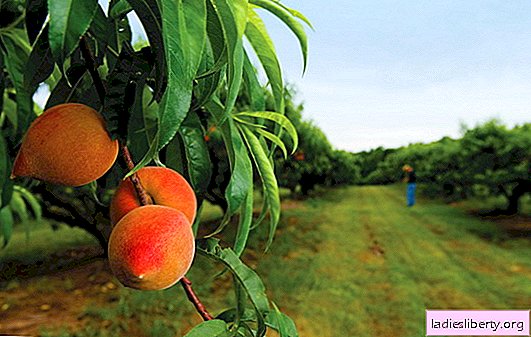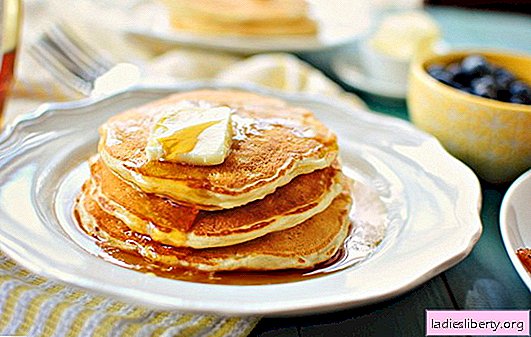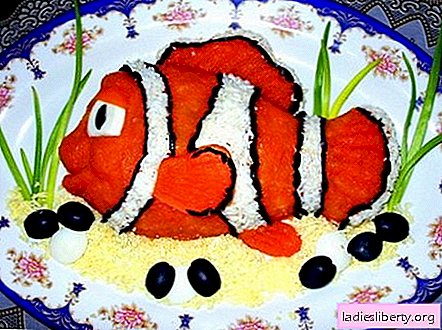
The peach tree is one of the oldest garden crops.
The value of this plant lies in the fact that its fruits are not only tasty and perfectly quench thirst, but also contain various mineral salts and vitamins.
In order to grow healthy peaches in your home garden, it is important to properly observe the agricultural technology of this crop.
Peach care: seedling selection, site preparation, planting
Rules for choosing peach seedlings
The right choice of peach tree seedling is one of the important criteria for its successful cultivation and harvest.
1. You need to buy seedlings in proven nurseries with a good reputation.
2. When purchasing a tree, pay attention to its root system and branches: they must be alive, not dry, without obvious signs of disease. They check it this way: you need to scratch your fingernail with a twig and look at the scratch: healthy wood will be shiny beige in color, moist and elastic, the cambium layer should be green in color. Living branches and roots are elastic, it is difficult to break them.
3. The variety must be selected taking into account the climatic conditions of the region.
4. During transportation, the selected seedling is wrapped in a bag or polyethylene, and the roots in a damp cloth.
5. Of the age categories, one-year-old trees take root better.
Where to plant a peach?
When choosing a place for planting a peach tree, several nuances must be taken into account:
• groundwater location;
• terrain;
• soil type (its physical properties and chemical composition);
• the size of the seedling itself.
The peach tree has stringent soil requirements. This culture does not tolerate stagnation of moisture, so wet, acidic heavy soils are not suitable for its cultivation. The best option would be chernozem or loamy areas. On light sandy soils, peach will require more frequent watering. In landing pits, a layer of drainage of stones or gravel of a large fraction is mandatory. You can not plant it in areas after raspberries, nightshade plants, strawberries, melons, alfalfa.
Peach needs good lighting, for this reason it is not worth planting fast-growing trees with a spreading crown next to it. Otherwise, shading will occur and the crown of the peach seedling will deform, the quality and yield of the fruit will decrease.
Peach Tree Planting Technique
Peach is a heat-loving culture, therefore, in central Russia it is planted in the spring in a pre-prepared place, and in the south it can be done in the fall. Landing pit is prepared from autumn to freezing soil. Its dimensions are approximately 0.7x0.7x0.6 m. Drainage is poured at the bottom of the pit, and on top of it a fertile mixture of humus and garden soil. Mineral fertilizers are also added. In the spring after the snow melts, it remains only to plant a seedling.

Planting a peach seedling
Its roots are distributed in the pit, they are covered with previously excavated earth and rammed tightly. After that, it is watered (3 buckets of water per 1 tree), making a groove or roller around the pit to prevent water from spreading. Then the trunk circle is mulched with sawdust, peat, dry leaves, and the seedling itself is tied to a support.
When planting in a row, the distance between the trees should be at least 3 meters.
Peach care: watering, top dressing, crown formation
Peach tree care consists in timely watering, fertilizer, periodic pruning and processing from pests and diseases.
Watering
The first watering is carried out when planting a seedling. A roller is made around the trunk circle to prevent water from spreading, and 3 buckets of water are spent on each tree. With a deficit of natural rainfall, peach trees are watered about 7-10 days before flowering. In a dry summer, watering is continued periodically. During this period, it is important not to overdo it and not turn the site into a swamp - peach trees do not tolerate waterlogging. 14 days before the planned fruit collection, watering is stopped so that the taste of peaches does not decrease.
Top dressing
Mulching the trunk circle will help preserve soil moisture and, accordingly, reduce the number of irrigations.
Two to three times during the entire growing season, they are fed with organic fertilizers: aqueous infusion of mullein (1:10) or chicken droppings (1:20). They can be replaced with a mineral mixture of ammonium nitrate, superphosphate and potassium chloride (2-3 tablespoons of each type in a bucket of water). Under each peach tree, 30 liters of the resulting solution are consumed. 10-14 days after flowering, for the prevention of chlorosis and shedding of the hearth ovaries, foliar dressing is carried out with a chelate of iron, boron, calcium.
Cropping and shaping the crown
For the full development of the peach tree and the quality of the future crop (fruiting occurs on the growth of last year), annual pruning is necessary. The first time it is done when planting a seedling. To form a crown, 3-4 skeletal branches are left, evenly spaced from each other. If some of them grow vertically, then they are bent at an angle of no more than 50 ° to the stem and fixed with twine. The remaining branches are cut into a ring. Slices are covered with varnish-balsam or garden var. The next year, on the skeletal branches leave branches of the second order at a distance of 0.3-0.4 m from the stem. Subsequently, all growths directed inward to the crown or vertically are cut out. Such pruning eliminates thickening and darkening of the crown, reduces the aging rate of the tree, and enhances the growth of fruiting branches.

Peach tree pruning scheme
For personal plots and summer cottages in peach trees, it is recommended to form a low-stem cup-shaped crown.
Peach Care in the Spring
Spring peach care begins with an examination of the plant. If branches damaged by frost are found, they are cut to a healthy tissue. Such pruning stimulates the growth of new shoots.
Before budding, the first peach trees are sprayed with fungicidal preparations (for example, 3% Bordeaux fluid, Topaz, Skor) to protect them from fungal diseases. Re-processing is carried out after 10-12 days. After spraying, the trunks and skeletal branches are whitened.
In the pink bud stage (before the flowers open), protection from insect pests (aphids, leaf moths, fruit moths, etc.) is needed. For this, insecticides are used, for example, Confidor, Vertimek, Fufanon.
After flowering, the third treatment of the garden with fungicides is carried out.
Peach Care: Major Diseases, Pests, and Pest Control
One of the most common peach tree diseases is leaf curlthe causative agent of which is a marsupial mushroom. He begins to actively parasitize in prolonged rainy weather. This disease is characterized by reddish swelling (in the initial period) on the leaves. After 7-10 days, a gray coating appears on the back of the leaves. The affected foliage curls and falls, the bare shoot dries up. In diseased trees, fruiting decreases, and if the ovaries appear, then they are deformed.

Peach leaf curl
To prevent the development of the disease in March, plants are sprayed with copper sulfate or with such drugs as Skor, Rayek, Topaz, Khom. After a week, the treatment is repeated. After the leaves appear, the affected shoots are cut and burned. In the fall, the fungicide treatment is repeated.
If during the flowering of peach trees the weather was wet, then development is possible moniliosis. This fungal disease causes browning and shedding of flowers, leaves and young fruit shoots. Not fallen fruits are covered with gray mold and rot. The carriers of fungal spores are insects. At the first manifestations of the disease, the affected parts of peach trees are cut and burned. Fallen rotten fruits cannot be left on the ground. They are collected and destroyed. As a prophylaxis, a 3-fold treatment with fungicides such as Gamair, Rovral, Abiga-Peak is carried out (before flowering, after its completion and 2 weeks after the second treatment).
Another common peach disease is kleasterosporiosisaffecting the entire aerial part of the plant. Red-brown spots appear on the leaves, the tissue under them dies and falls out, forming holes. Hence the second name of the disease - hole spotting.

The manifestation of clasterosporosis on peach tree leaves
They begin to fight it in the spring: infected branches are cut off, the places of the cuts are disinfected with a solution of iron or copper sulfate, 3-fold spraying with fungicides is carried out (during bud swelling, before and after flowering).
In high humidity, peaches may be affected in summer. scab. The first signs of the disease are greenish-brown with a blurred border spots on the fruits and leaves. Gradually, the spots merge and become covered with a black crust, through which, when cracked, infection occurs with fruit rot. The bark on the shoots locally swells, breaks and takes the form of scabs. Fighting with scab lies in the same methods. As with other fungal bone diseases.
Of insect pests, peach is damaged by fruit moths, aphids, scale insects, weevils, flower beetles, eastern moth, spider mites. For their destruction, insecticides are used (Karbofos, Agrovertin, Actellik, Spark, Biotlin and others).











